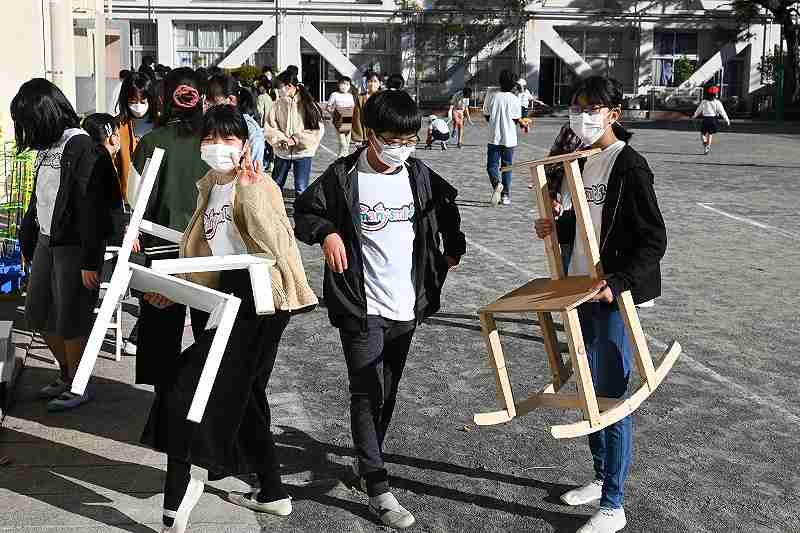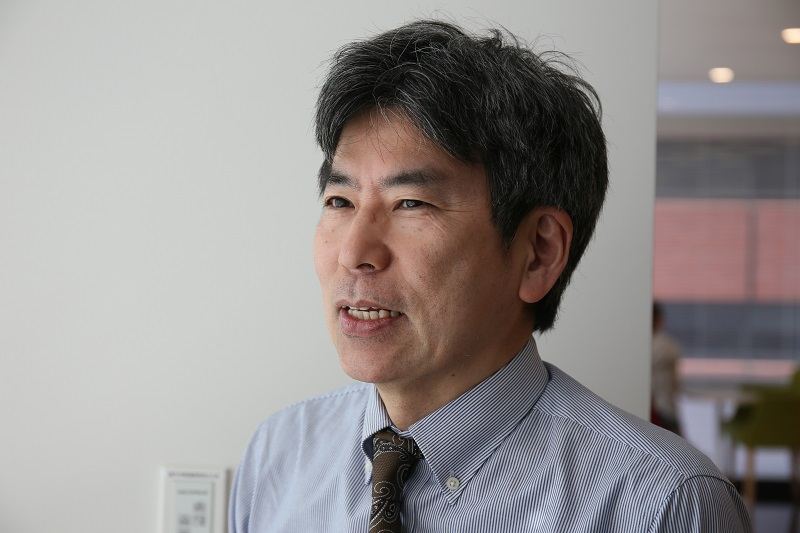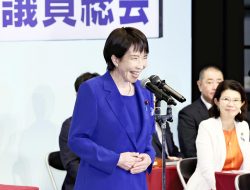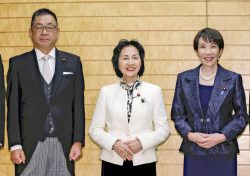
After building a mini amusement park, children at Setagaya Elementary School carried their handmade chairs into the schoolyard on Nov. 25. Afterward, they enjoyed tea with their handmade mugs.
8:00 JST, January 7, 2023
Many of you may think that a teacher’s role is to teach. You may also think that children primarily learn when a teacher pours knowledge into their heads. That is what teaching was all about for a long time, but not anymore. Teachers are now expected to guide children so that they can learn on their own. This new role seems to hold the key to children’s well-being in schools.
Elementary school teachers from all over Japan came to Setagaya Elementary School in Setagaya Ward, Tokyo, in November. The school opened its “integrated studies” classes to the teachers, who had gathered for a national conference to learn how to teach this way.
“Integrated studies” is cross-curricular learning that is being implemented in elementary and junior high schools in Japan. Children can learn problem-solving skills by working on various projects related to real-life issues.
I participated in the two-day event. In every classroom, I saw lively, motivated children who seemed to know what they had to do.
In the fifth-grade class, for example, the children were thinking about how to make rice crackers from rice they had grown by themselves. Some were threshing the harvested rice, while others were designing a cooking stove with bricks. Some offered to manage the entire schedule and budget.
In the sixth-grade classes, some were taking care of goats, while others were building athletic equipment. The children explained that they planned to combine their activities to create a “mini amusement park” for the enjoyment of all the other children.
“Students act proactively without instructions from the teacher,” said Kyosuke Murakami, 35, one of the sixth-grade homeroom teachers.
“You can be friends with anyone so easily in this school,” said sixth-grade girl Mitsuki Tsuchiya, 12.
Sakura Inose, also 12, said: “In the integrated studies that the school is focusing on, we think for ourselves a lot. The teachers let us do whatever we think of. They even let us keep goats after we asked to.”
Principal Yoshimi Kaneko, 53, clarified that teachers don’t simply let the students do whatever they want to do. “We thoroughly prepare the learning environment for them. For example, to identify the possibilities and problems with goats in advance, we visited several schools that have had goats. We also made sure that the goats would not disturb the neighbors,” he said.
“We want to create a fun school, where everyone has a place to belong and no one is left behind. To achieve this, it is important to make students believe that they can do what they want to do,” the principal emphasized.
He also said that some children who used to be reluctant to come to school now come for integrated studies.
During integrated studies, children mobilize the knowledge and skills they have learned in various subjects, including Japanese, math and science, and think about solutions to various issues such as social welfare, international understanding and environmental problems.
This is becoming increasingly important in school education because it gives children the ability to adapt and thrive in an unpredictable era of constant change. Children learn the thinking processes necessary to solve problems by identifying issues in their local communities or daily lives, thinking about what to do, and proceeding through trial and error.
I used to be an expert member of the Central Council for Education, an advisory body for the education minister, and took part in the revision of the National Curriculum Standard in the working group for integrated studies. As many members pointed out in the working group’s discussions, integrated studies time also helps children enjoy school, and I think this is very important for children’s well-being.
According to a UNICEF report released in 2020 on the well-being of children in developed countries, the percentage of children with high life satisfaction at 15 years of age in Japan is 62%. This was the second-worst result among 33 countries, better than only Turkey. The percentage of Japanese of the same age who said they make friends easily was 69%, also the second-worst, better than only Chile. One-third of children in Japan may not be having a good time at school.
The best way for children to have an enjoyable school life is to make school more attractive. Two things are said to be necessary for this to happen. First, lessons should be fun and easy to understand. Second, students should be able to enjoy their friendships. I believe that both can be achieved to a great extent through integrated studies time.
At the schools I visited, several principals confessed that before they had started to focus on integrated studies, a considerable number of students had been reluctant to come to school — but not anymore. Students feel secure and can concentrate on the lessons.
As the Education, Culture, Sports, Science and Technology Ministry focuses on promoting integrated studies, many teachers come to participate in study conferences and open classes at advanced schools to learn how to do it. They see children learning in a lively way and are eager to bring about the same at their own schools. However, it is not easy because the practices brought back from advanced schools are so different from the kind of lessons that most teachers know.
In many schools, everything tends to be railroaded by the teachers, regardless of what the children want to do or know. When a seaside school chooses “hometown industry” as an issue to explore, for instance, visits to fishing ports, fish markets, seafood processing plants and so on may be scheduled as school events from the beginning of the school year. It is as if all children are supposed to be equally interested in the same things and have the same questions every year. Such a plan will not inspire the children to learn on their own.
Perhaps this is because a lot of teachers feel obliged to teach as much as they can. They have a strong sense that their job is to “teach” — in the old sense of that term. They may think that if they do not teach much, they will be considered lazy.
The same is true for parents. When children learn on their own, parents often complain that their children’s teachers aren’t teaching them anything. Bowing to this pressure, some schools have actually cut back on integrated studies and have gone back to the old-fashioned cramming style of lectures.
When children are free to do what they want to do, it doesn’t mean that we release them from all guidance. Teachers should examine children’s requests in detail and consider their feasibility and relationship to the relevant subject matter before leaving the work to them. No matter how carefully the teachers carry out such a feasibility study, the issue the children have identified may sometimes prove to be not worth exploring. If that happens, you can just go for another issue.
For the teachers at Setagaya Elementary School, changing their mindset was not easy. They could not understand at first why they should not teach so much. But now it is different. Children are more active and confident than before. In a survey of the national assessment of academic ability, the percentage of the students who gave a positive answer to a question asking if they recognized good qualities in themselves was higher than 90%, well above the national average.
So why not let the children do what they want to do and see what happens? No matter what subject a teacher is teaching, knowing what the children want to do should be essential to enrich learning. All we need to do is to trust children’s abilities a little more. Once we realize that children are by nature active learners, schools will be more enjoyable places, not just for the children, but for the teachers as well.
Political Pulse appears every Saturday.

Makoto Hattori
Hattori is a staff writer in the Education News Department of The Yomiuri Shimbun
"Editorial & Columns" POPULAR ARTICLE
-

Violations of Subcontract Law: Major Automakers Must Eliminate Old Practices
-

Local Governments’ Tax Revenues: Devise Ways to Correct Imbalances in Tax Sources
-

5 Japanese Business Dinner Mistakes to Avoid — and What They Taught Me About Business in Japan
-

Heavy Rains in Asia: Support for Victims, Flood-Control Measures Urgently Needed
-

New Nuclear Threat: China Seeking to Follow U.S., Russia in Military Expansion
JN ACCESS RANKING
-

Keidanren Chairman Yoshinobu Tsutsui Visits Kashiwazaki-Kariwa Nuclear Power Plant; Inspects New Emergency Safety System
-

Imports of Rare Earths from China Facing Delays, May Be Caused by Deterioration of Japan-China Relations
-

University of Tokyo Professor Discusses Japanese Economic Security in Interview Ahead of Forum
-

Japan Pulls out of Vietnam Nuclear Project, Complicating Hanoi’s Power Plans
-

Govt Aims to Expand NISA Program Lineup, Abolish Age Restriction

























